
The Vorthos Guide to Magic: The Gathering
Today we rewind the clock way back to cover one of the most important events in Magic’s history, and to start us on a path as we explore the pre-mending world of Magic: the Gathering. The Brothers' War is an event that ended with the devastation of a plane, the birth of the Ice Age, and the ascension of Urza Planeswalker. This is the event that defined the rest of Urza's life and shaped his personal war with Phyrexia for millennia to come.
Welcome to The Brothers' War, the launching point of all revisionist Magic lore. For those of you wondering, the revision began when Wizards of the Coast began creating a centralized story for Magic, beginning with Rath and moving into the present day. Before this time, most Magic fiction was relatively generic, or told through an Armada Comics line of comic books. When they published the Rath story in The Duelist and then as Rath and Storm, it was their first real cohesive attempt at storytelling for Magic, The Weatherlight Saga. The conflict between Urza Planeswalker and Phyrexia was center stage for years, but Urza was still a mysterious character. The Brothers' War is the defining event that kicked off everything that was to follow in Magic’s story.
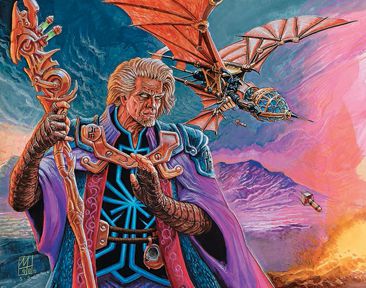
Urza: Only the 'good' guy because the bad guys are so much worse.
Vanguard Urza Art by Mark Tedin
Setting the Stage
Although the events of the Brothers' War (then called the Antiquities War) was somewhat covered before the novel, the novel is the defining revisionist account of that period. Since in some cases, more than two decades have passed since the release of the Armada comics, The Duelist, and many of the pre-revisionist novels, I will not cover them in this article. This is in part because finding first-hand sources is such a challenge these days, and in part because they simply are not particularly relevant anymore, having been either retconned or largely ignored in later fiction.
What we will cover today includes the excellent novel The Brothers' War and the prologue of its sequel, Planeswalker. In addition, because it wraps up the story of a relatively major character from the novel, we will also cover Loran’s Smile, which has been published online but originally ran as a short story in The Duelist.
Geography
The story of The Brothers' War takes place on a continent of Dominaria called Terisiare. Terisiare is a continent divided into three large coastal nations and a Great Desert. The three coastal nations were, from north to south: Argive, Korlis, and Yotia (and its capital Kroog). All three were located on the eastern coast, although Yotia was divided from Argive and Korlis by the Kher Ridges. To the north of Argive was the Sardian Mountains. Unbeknownst to the coastal nations, the lush Island of Argoth lay just off-shore to the southeast.
In the center of the continent lay the Great Desert, a huge expanse that stretched halfway across the continent, from the Kher Ridges past Ronom Lake. It was once the home of the Thran civilization, and their ruins are scattered throughout. Their greatest city, dubbed Koilos by Urza, was built into the high peaks of the Kher Ridges. The Great Desert was home to two great settlements: Tomakul in the north and Zegon in the south. North of the Great Desert lay Ronom Lake, which was fed by Ronom Glacier farther to the north. The western coast was home to the Island of Lat-Nam, the land of Sarinth, and the city of Terisia.
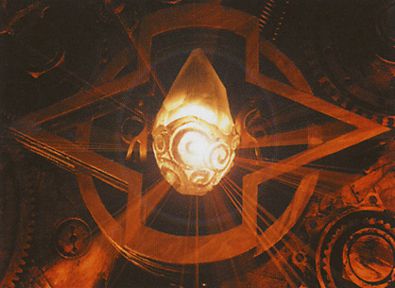
For all their importance, powerstones themselves only have two cards.
Worn Powerstone by Henry G. Higginbotham
Politics
Central to the plot of the Brothers' War is the concept of artifice. At this point, the main civilizations of Dominaria had not even scratched the surface of magic, and so artifacts were the focus of power. Because Terisiare was the home of the ancient Thran civilization, the people had access to all sorts of ancient Thran technology and replicated it to a small extent. The limiting factor was the supply of powerstones, gems created by the Thran that could power artifacts and also act as a sort of basic CPU.
The main nations of Terisiare were Argive, Korlis and Yotia. Argive was a monarchy and fairly modern due to their investments in Thran technology. They were modern by the standards of the continent, and their nobility would often send troublesome youth on expeditions into the desert to discover Thran artifacts. The largest and most successful of these expeditions was run by a scholar named Tocasia. Korlis was a city-state run by a ruling merchant class to the south of Argive.
Yotia was located across the Kher Ridges from Argive, and directly adjacent to the Great Desert. Yotia was ruled by a monarchy, although the head of that monarchy was known as the Warlord. At the time leading up to the Brothers' War, the current Warlord had absorbed the smaller nations around his own until he controlled everything from the Great Desert to the Kher Ridges.
The Fallaji were a mostly nomadic people who lived in the Great Desert. They were divided into tribes, with the capital (of sorts), Tomakul, being controlled by the tribe of the same name. Later, a far more brutal tribe known as the Suwwardi would eventually gain control over all of the tribes. They had two large settlements, used mostly for the merchants of their people to trade with other nations. The Fallaji consider Thran ruins and artifacts to be anathema.
Smaller nations of note include Terisia City, which was a city-state of scholars, ultimately controlled by a woman called the archmandrite. The mountains of Sardia were home to a civilization of dwarfs that traded with the Argivians, but ultimately not much more is known about them and by the end of the war they were wiped out. Argoth was home to the final battle of the Brothers' War. It was controlled by the elemental Titania, and populated by all sorts of magical creatures.

Magic's artwork hasn't always been great at depicting women.
Vanguard Ashnod Art by Ron Spencer
Characters
- Tocasia - An aging scholar digging through the Thran Ruins in the Great Desert.
- Loran - Tocasia’s star pupil, before the arrival of Mishra and Urza
- Urza - A quiet but intense man, not very good with people skilled with artifice.
- Mishra - Urza’s younger brother, and his opposite. Brash and charismatic, and about as skilled with artifice as his brother.
- Kayla Bin-Kroog - The princess of Yotia, a spoiled brat turned strong leader.
- Harbin - The son of Kayla and one of the brothers, more likely Urza than Mishra.
- Tawnos - Urza’s apprentice, former toymaker, a strong, thoughtful and clever man
- Ashnod - Mishra’s apprentice, self-taught until meeting Mishra, a complex and ruthless woman.
- Gix - A Phyrexian Demon who was the first to discover the portal to Phyrexia has been reopened, and begins plotting Phyrexia’s return.
- Feldon - A scholar who has spent his life excavating the Ronom Glacier.
- Drafna - Co-founder of the college of Lat-nam. As loud and brash as his wife was quiet and insightful.
- Hurkyl - Drafna’s wife, former pupil, co-founder of the College of Lat-Nam and secretly a powerful blue mage.
Story of The Brothers' War
Desert Origins
Tocasia was an Argivian scholar, probably one of the most successful, conducting archeology in the Great Desert. She spent her days looking for Thran ruins, artifacts and most importantly, powerstones. So far, all she uncovered are broken pieces of Thran constructs (called Su-Chi, bow-legged insectile soldiers). She was aided by a small group of Fallaji diggers, who do not particularly like going after Thran artifacts (as it is taboo), but in general anything outside of major ruins is fair game. One of Tocasia’s most promising students was a young woman named Loran, who, like a lot of her pupils, was sent to her as a way of curing a rebellious nature. Sending difficult children to spend a summer working in the desert was a fairly common tactic by Argivian parents.
One day, her usual supply caravan brought her unexpected guests: two young boys, recently orphaned. The older boy’s name was Urza, and the younger’s was Mishra. Tocasia learns that these two boys were the sons of an Argivian noble, and were quickly sent for her protection rather than being left to the mercies of their step-mother upon the death of their father. Their father, it is revealed, had freed Tocasia from slavery decades before, and so Tocasia took the boys in. They quickly revealed themselves to be her most adept pupils. While they were initially inseparable, they have vastly different personalities that begin to create friction and distance between them as they grow older. Urza is relatively cold and focused, while his younger brother Mishra is charismatic and charming - and reckless. As they grow, they become hallmarks of Tocasia’s camp.
Eventually, the two discover the most intact example of an Ornithopter (a Thran flying device) and repair it together, but Urza’s harsh criticism of Mishra begins a rivalry that will last for the rest of their lives. While Urza seems colder and crueler than Mishra, he simply does not understand how to relate to his brother, and their sibling rivalry is mixed with his concern for his brother’s well-being. To Mishra, this simply seems like his older brother is jealous and mean. This split eventually leads Mishra to spending more time with the Fallaji diggers working in the camp, befriending a young man named Hajar in particular.
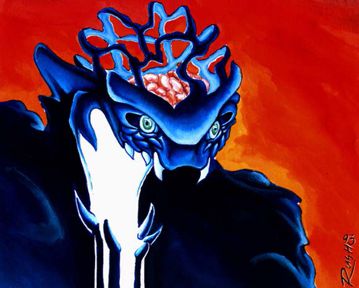
If I discovered an ancient civilization that built these, I'd stop digging.
Su-Chi by Christopher Rush
The two take turns conducting test flights of their repaired Ornithopter, and they discover that when viewed from above, there appear to be drawings in the desert. They argue over what they mean, until they realize that these drawings are intended as aerial guides - leading them to richer Thran ruins, and eventually to the secret Thran city of Koilos high in the mountains in a place no one could reach easily on foot. The head Fallaji digger warns Tocasia against pursuing this - digging up scrap in the desert is one thing, but the other Fallaji won’t tolerate it if they violate Koilos, which is a forbidden place to them. Heedless, Urza, Mishra and Tocasia make the journey together, following the signs and reach Koilos. Koilos is a ruin, but they’re forced to land after an encounter with a giant bird attacking their Thopter.
After landing, they run for cover in a nearby cave, which turns out to be an entrance to an ancient Thran ruin, better preserved than they ever encountered before. Su-Chi line the walls, somewhat in disrepair but in better shape than any they had uncovered. The trio continues inward and discovers the most advanced Thran device they ever seen - and the largest powerstone they ever laid eyes on. The brothers reach for the stone, Urza trying to prevent Mishra from touching it, and they are engulfed in a bright explosion. The two brothers have opposing visions. Urza sees a Thran device forcing people to their deaths, and Mishra sees a metal world with machine dragons. The two awake, and find that they are each holding half of the powerstone. Koilos’ defenses activate, forcing them to flee, and along the way they discover that each half has a different ability - Urza’s infuses things with power, while Mishra’s drains strength. Urza dubs these the Mightstone and Weakstone, to Mishra’s chagrin. They use the abilities of both to successfully escape Koilos and return to camp, each coveting the other’s stone.
Soon after, Mishra - drunk and bitter - tries to steal Urza’s stone from his tent. Urza is awake, however, and they use the stones to fight one another, but when Tocasia attempts to stop them from fighting, the stone’s power kills her. Horrified, Mishra flees into the desert that very night. The camp falls apart without Tocasia, the Fallaji diggers abandon the scholars who in turn pack up to leave themselves, as they are no longer safe from Fallaji raiders.
The Brothers Ascendant
Some time later, Urza lives in Yotia’s capital of Kroog. He has become an assistant to a man named Rusko at Rusko’s clock shop. It’s a giant step down for Urza, but he doesn’t seem to know what to do with his life. With no formal training to speak of, one of the best artificers on Dominaria is reduced to repairing timepieces. The solution comes in the form of the princess of Yotia, Kayla bin-Kroog, daughter of the Warlord. She travels to every shop in the city to find one that can repair her mother’s music box. Rusko, although boisterous, cannot, but Urza fixes it in a matter of moments - impressing the princess.
Kayla is a bit of a spoiled brat at first, and her father decides that none of her suitors are up to his standards. Being the Warlord, he wants to marry his daughter to man strong enough to fill his shoes. He opens up the treasury to a man that can meet his challenge, and every weekend men come and fail his test. Rusko eventually convinces Urza to come with him and watch, and while there Urza realizes that part of the treasure haul the Warlord is offering includes a Thran tome. Inspired once more, he begs a loan from Rusko and sets to work. At the next contest, Urza shows up with a metal man, a variation of the Su-Chi that is less insectile and more human. The Su-Chi moves what other humans could not, and Urza wins both the princess and the prize horde. The Warlord is furious, but he is convinced that a man of Urza’s skill would make Yotia even stronger. Urza is made the princess’ consort and Master Artificer. For Urza, all that matters is that he has the resources to pursue his goals once more
Mishra did not fare as well as his brother. After fleeing Tocasia’s camp, he was captured by Fallaji raiders and enslaved by the Suwwardi clan. His life was saved by his Fallaji friend Hajar, who has joined the Suwwardi as they began growing in power. He was presented to the Qadir of the Suwwardi and he used his education to become the tutor of the Qadir’s son. He remained a slave, however, and the Qadir holds his weakstone. As his time went on, he earned the boy’s trust and began to influence the boy far more than his father would like. The Qadir ordered Mishra’s death, but Mishra was saved by the sudden appearance of a Mak Fawa, the Fallaji word for Dragon Engine. He dreamt of a Dragon Engine chasing him, and when he woke one erupted into the middle of the Fallaji camp (which coincidentally was located at the time over top of Thran Ruins). With the help of Hajar, he reclaimed the weakstone and tamed the Dragon Engine. The new Qadir freed Mishra and made him the tribe’s wizard, second only in power to the Qadir.
Thanks for reading! This was our first foray into pre-mending lore, so we hope you enjoyed it! You won't have to wait long to find out what happens next, as Part II comes out in just two weeks!
Did we miss anything? Let us know in the comments or on the forum, and we’ll address it in future updates. Have a suggestion for something you’d like to see? Let us know, and we could address it in a future column.
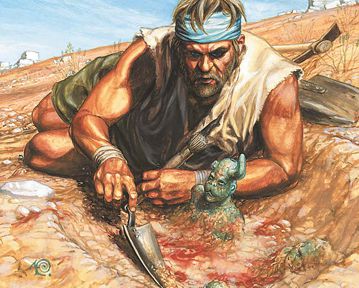
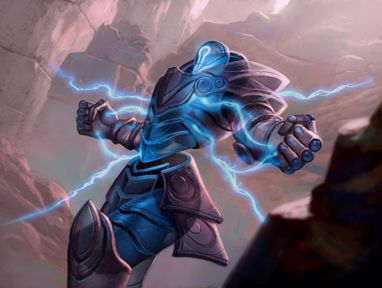
-
View User Profile
-
Send Message
Posted Apr 26, 2016-
View User Profile
-
Send Message
Posted Apr 26, 2016And I do like Ashnod, she's a great morally gray character.
-
View User Profile
-
Send Message
Posted Apr 18, 2016-
View User Profile
-
Send Message
Posted Apr 8, 2016I'm really interested in the lore of legends, mirage block (the 1st part not weatherlight). Basically the stuff that is more obscure and barely talked about.
-
View User Profile
-
Send Message
Posted Apr 7, 2016-
View User Profile
-
Send Message
Posted Apr 7, 2016